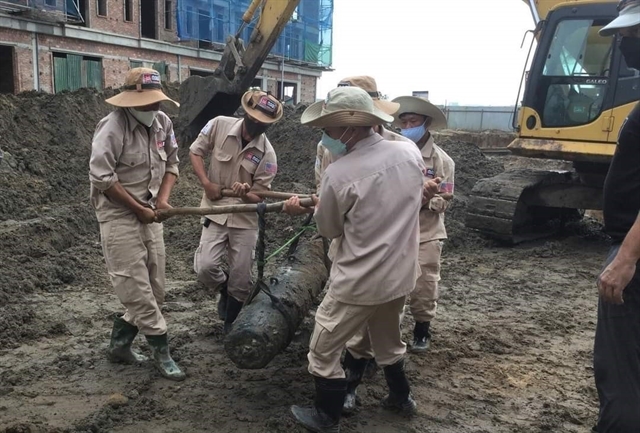 Society
Society


|
| Members of Mines Advisory Group (MAG) Quảng Bình transfer a bomb weighing nearly 230 kg found near a market in Đồng Hới City in the central province of Quảng Bình. VNA/VNS Photo |
HÀ NỘI — Landmines and other explosive remnants of war remain a threat to life and sustainable development in Southeast Asia, said experts at a two-day conference in Hà Nội.
The conference, named "Mine Action for Sustainable Peace and Development: Exchanging regional experience and global innovations in mine action", was organised by the Ministry of Foreign Affairs, Korea International Cooperation Agency (KOICA), and the United Nations Development Programme (UNDP) in Việt Nam.
The event featured seven sessions discussing diverse topics, including sharing experience of Việt Nam, Laos, Cambodia and Thailand in the effort; the importance of effective information management; the tripartite cooperation model of UNDP/KOICA/Việt Nam, overcoming the consequences of landmines in the overall fulfillment of the sustainable development goals, technological advances and regional cooperation mechanisms in the field.
Đỗ Hùng Việt, Vice Minister of Foreign Affairs, said: “Mine action should not be seen as a short-term, temporary humanitarian solution, but as an inclusive and comprehensive process towards post-conflict recovery, reconstruction, and peacebuilding, realising the Sustainable Development Goals (SDGs) while being people-centered and leaving no one behind.”
Within the framework of the National Action Programme on Settling Consequences of Unexploded Ordnance (Programme 504) for the 2010-2020 period, Việt Nam has pooled resources worth more than VNĐ12 trillion (US$521 million) and cleared more than 500,000 hectares of contaminated land to create space for development, he said.
UNDP Resident Representative in Việt Nam Ramla Khalidi said: “Mine action saves and changes lives. Our goal is not only to clear contaminated land but also to ensure that cleared land is integrated with rural development planning efforts and is a vehicle to promote peaceful and sustainable communities.”
Country director of KOICA Việt Nam Han-Deog Cho said: “We have launched the second intervention project for mine action, which is called KVPVP (Korea-Việt Nam Peace Village Project) in Việt Nam on a bigger scale and adding a livelihood support component.
“KVPVP will inherit the positive results from the 1st phase and bring about inclusive, safe, and resilient local development by reducing the impacts of explosive ordnance,” he said.
New technology on mine action in Southeast Asia can contribute to sustainable changes on the ground, according to experts.
In Cambodia, the government is using drones to detect landmines and thereby ensuring that surveys are cheaper, faster and safer than before. In Việt Nam, an online registry and information management system for persons with disabilities and unexploded ordnance survivors has been established to conduct an assessment in the country’s most contaminated provinces of Quảng Bình and Bình Định.
Half a century after the Paris Peace Accords were signed, millions of people in Việt Nam, Cambodia, and Laos PDR remain at risk. Between 1964 and 1973, 7.5 million tonnes of ordnance fell on the three countries. Nearly a fifth of Viet Nam, 5.6 million hectares, is potentially contaminated by explosive ordnance. Approximately 600,000 to 800,000 tonnes of unexploded ordnance could still be hidden underground.
KOICA and UNDP have worked with the Government of Việt Nam to overcome the consequences of landmines and unexploded ordnance. In three years, the project has surveyed 17,000 hectares of land, equivalent to 20,000 football fields, and 10,000 contaminated hectares were cleared. Meanwhile, 450,000 local people have received education on the risk of unexploded ordnance.
Việt Nam has set the goal of having no more landmine accidents or explosions nationwide by 2025. — VNS




